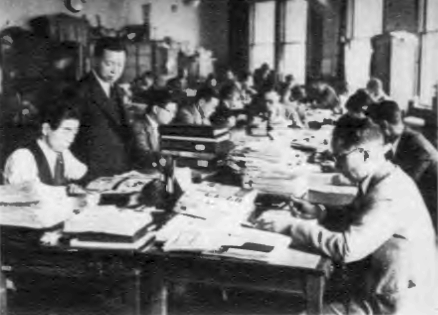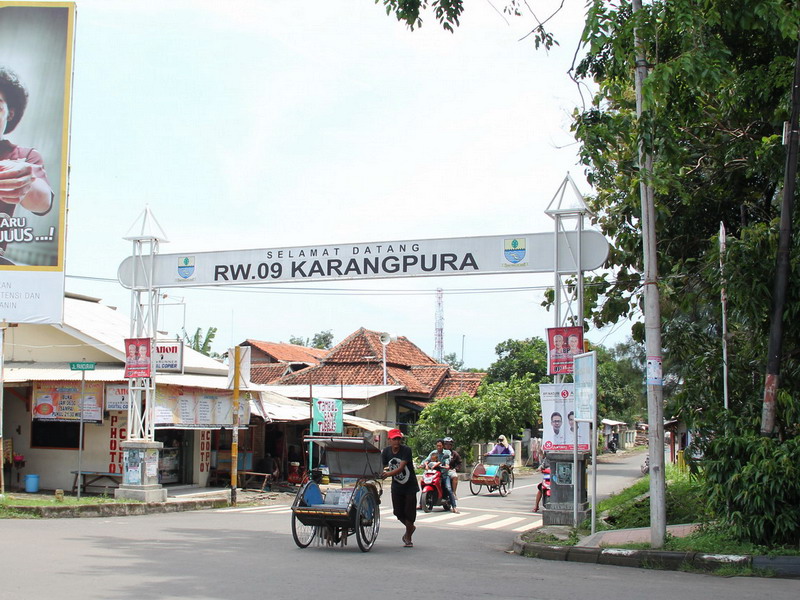|
Tonarigumi
The was the smallest unit of the national mobilization program established by the Japanese government in World War II. It consisted of units consisting of 10-15 households organized for fire fighting, civil defense and internal security. History and development Neighborhood mutual-aid associations existed in Japan since before the Edo period. The system was formalized on 11 September 1940 by order of the Home Ministry (Japan) under Imperial Rule Assistance Association by the cabinet of Prime Minister Fumimaro Konoe. Participation was mandatory. Each unit was responsible for allocating rationed goods, distributing government bonds, fire fighting, public health, and civil defense. Each unit was also responsible for assisting the National Spiritual Mobilization Movement by distribution of government propaganda and organizing participation in patriotic rallies. The government also found the ''tonarigumi'' useful for the maintenance of public security. A network of informants was ... [...More Info...] [...Related Items...] OR: [Wikipedia] [Google] [Baidu] |
Tokubetsu Kōtō Keisatsu
The , often abbreviated , was a Japanese policing organization, established within the Home Ministry in 1911, for the purpose of carrying out high policing, domestic criminal investigations, and control of political groups and ideologies deemed to threaten the public order of the Empire of Japan.W. G. Beasley, ''The Rise of Modern Japan'', p. 184, . As the civilian counterpart to the military police forces of the ''Kenpeitai'' (army) and of the '' Tokkeitai'' (navy), the Tokkō's functions were criminal investigation and counter-espionage. The Tokubetsu Kōtō Keisatsu was also known by various nicknames such as the and as the . History The High Treason Incident of 1910 was the stimulus for the establishment of the Tokkō under the aegis of the Home Ministry. With the Russian Revolution, unrest at home due to the Rice Riots of 1918, increase in strikes and labor unrest from the labor movement, and Samil Uprising in Korea, the Tokkō was greatly expanded under the administration ... [...More Info...] [...Related Items...] OR: [Wikipedia] [Google] [Baidu] |
Empire Of Japan
The also known as the Japanese Empire or Imperial Japan, was a historical nation-state and great power that existed from the Meiji Restoration in 1868 until the enactment of the post-World War II 1947 constitution and subsequent formation of modern Japan. It encompassed the Japanese archipelago and several colonies, protectorates, mandates, and other territories. Under the slogans of and following the Boshin War and restoration of power to the Emperor from the Shogun, Japan underwent a period of industrialization and militarization, the Meiji Restoration, which is often regarded as the fastest modernisation of any country to date. All of these aspects contributed to Japan's emergence as a great power and the establishment of a colonial empire following the First Sino-Japanese War, the Boxer Rebellion, the Russo-Japanese War, and World War I. Economic and political turmoil in the 1920s, including the Great Depression, led to the rise of militarism, nationa ... [...More Info...] [...Related Items...] OR: [Wikipedia] [Google] [Baidu] |
Imperial Rule Assistance Association
The , or Imperial Aid Association, was the Empire of Japan's ruling organization during much of World War II. It was created by Prime Minister Fumimaro Konoe on 12 October 1940, to promote the goals of his ("New Order") movement. It evolved into a "statist" ruling political party which aimed at removing the sectionalism in the politics and economics in the Empire of Japan to create a totalitarian one-party state, in order to maximize the efficiency of Japan's total war effort in China. When the organization was launched officially, Konoe was hailed as a "political savior" of a nation in chaos; however, internal divisions soon appeared. Origins Based on recommendations by the , Konoe originally conceived of the Imperial Rule Assistance Association as a reformist political party to overcome the deep-rooted differences and political cliques between bureaucrats, politicians and the military. During the summer of 1937, Konoe appointed 37 members chosen from a broad political spe ... [...More Info...] [...Related Items...] OR: [Wikipedia] [Google] [Baidu] |
Rukun Warga
A ''rukun warga'' (abbreviated RW, literally "pillar of residents") is an administrative division of Indonesia under the village or ''kelurahan'' (or under: ''dusun'' or village). , and the formation of local communities is through consultation in the framework of community service set by the village or villages. An RW is further divided into '' rukun tetangga'' (RT). Most information about governance and functioning of the RW and RT is in Indonesian. Some non-Indonesian anthropologists have written about the functions and issues of the RW. See also * Barangay * Tonarigumi The was the smallest unit of the national mobilization program established by the Japanese government in World War II. It consisted of units consisting of 10-15 households organized for fire fighting, civil defense and internal security. Histo ... Notes Subdivisions of Indonesia * Indonesia, Villages Law of Indonesia Society of Indonesia {{Indonesia-stub ... [...More Info...] [...Related Items...] OR: [Wikipedia] [Google] [Baidu] |
Rukun Tetangga
A ''rukun tetangga'' (abbrievated RT, literally "pillar of neighbours") is an administrative division of a village in Indonesia, under a ''rukun warga''. The RT is the lowest administrative division of Indonesia. The ''rukun tetangga'' operates through consultation in the framework of community service, set by the village or villages. The local level of governance of ''rukun warga'' and ''rukun tetangga'' also includes the ''rukun kampung'' A ''rukun tetangga'' is chaired by a ''ketua RT'' elected by its citizens. An RT consists of a number of households (''KK''). Most information about governance and functioning of the RT and RW is in Indonesian. Some non-Indonesian anthropologists have written about the functions and issues. See also * Barangay * Tonarigumi The was the smallest unit of the national mobilization program established by the Japanese government in World War II. It consisted of units consisting of 10-15 households organized for fire fighting, civil defens ... [...More Info...] [...Related Items...] OR: [Wikipedia] [Google] [Baidu] |
:Category:Japanese Words And Phrases ...
{{Commons Words and phrases by language Words Words Words A word is a basic element of language that carries an objective or practical meaning, can be used on its own, and is uninterruptible. Despite the fact that language speakers often have an intuitive grasp of what a word is, there is no consen ... [...More Info...] [...Related Items...] OR: [Wikipedia] [Google] [Baidu] |
Supreme Commander Of The Allied Powers
was the title held by General Douglas MacArthur during the United States-led Allied occupation of Japan following World War II. It issued SCAP Directives (alias SCAPIN, SCAP Index Number) to the Japanese government, aiming to suppress its "militaristic nationalism". The position was created at the start of the occupation of Japan on August 14, 1945. In Japan, the position was generally referred to as GHQ (General Headquarters), as SCAP also referred to the offices of the occupation (which was officially referred by SCAP itself as ), including a staff of several hundred US civil servants as well as military personnel. Some of these personnel effectively wrote a first draft of the Japanese Constitution, which the National Diet then ratified after a few amendments. Australian, British Empire, and New Zealand forces under SCAP were organized into a sub-command known as British Commonwealth Occupation Force. These actions led MacArthur to be viewed as the new Imperial force in Japan ... [...More Info...] [...Related Items...] OR: [Wikipedia] [Google] [Baidu] |
Sakhalin
Sakhalin ( rus, Сахали́н, r=Sakhalín, p=səxɐˈlʲin; ja, 樺太 ''Karafuto''; zh, c=, p=Kùyèdǎo, s=库页岛, t=庫頁島; Manchu: ᠰᠠᡥᠠᠯᡳᠶᠠᠨ, ''Sahaliyan''; Orok: Бугата на̄, ''Bugata nā''; Nivkh: Yh-mif) is the largest island of Russia. It is north of the Japanese archipelago, and is administered as part of the Sakhalin Oblast. Sakhalin is situated in the Pacific Ocean, sandwiched between the Sea of Okhotsk to the east and the Sea of Japan to the west. It is located just off Khabarovsk Krai, and is north of Hokkaido in Japan. The island has a population of roughly 500,000, the majority of which are Russians. The indigenous peoples of the island are the Ainu, Oroks, and Nivkhs, who are now present in very small numbers. The Island's name is derived from the Manchu word ''Sahaliyan'' (ᠰᠠᡥᠠᠯᡳᠶᠠᠨ). Sakhalin was once part of China during the Qing dynasty, although Chinese control was relaxed at times. Sakhalin was l ... [...More Info...] [...Related Items...] OR: [Wikipedia] [Google] [Baidu] |
Korea
Korea ( ko, 한국, or , ) is a peninsular region in East Asia. Since 1945, it has been divided at or near the 38th parallel, with North Korea (Democratic People's Republic of Korea) comprising its northern half and South Korea (Republic of Korea) comprising its southern half. Korea consists of the Korean Peninsula, Jeju Island, and several minor islands near the peninsula. The peninsula is bordered by China to the northwest and Russia to the northeast. It is separated from Japan to the east by the Korea Strait and the Sea of Japan (East Sea). During the first half of the 1st millennium, Korea was divided between three states, Goguryeo, Baekje, and Silla, together known as the Three Kingdoms of Korea. In the second half of the 1st millennium, Silla defeated and conquered Baekje and Goguryeo, leading to the "Unified Silla" period. Meanwhile, Balhae formed in the north, superseding former Goguryeo. Unified Silla eventually collapsed into three separate states due to ... [...More Info...] [...Related Items...] OR: [Wikipedia] [Google] [Baidu] |
Militia
A militia () is generally an army or some other fighting organization of non-professional soldiers, citizens of a country, or subjects of a state, who may perform military service during a time of need, as opposed to a professional force of regular, full-time military personnel; or, historically, to members of a warrior-nobility class (e.g. knights or samurai). Generally unable to hold ground against regular forces, militias commonly support regular troops by skirmishing, holding fortifications, or conducting irregular warfare, instead of undertaking offensive campaigns by themselves. Local civilian laws often limit militias to serve only in their home region, and to serve only for a limited time; this further reduces their use in long military campaigns. Beginning in the late 20th century, some militias (in particular officially recognized and sanctioned militias of a government) act as professional forces, while still being "part-time" or "on-call" organizations. For instan ... [...More Info...] [...Related Items...] OR: [Wikipedia] [Google] [Baidu] |
Pacific War
The Pacific War, sometimes called the Asia–Pacific War, was the theater of World War II that was fought in Asia, the Pacific Ocean, the Indian Ocean, and Oceania. It was geographically the largest theater of the war, including the vast Pacific Ocean theater, the South West Pacific theater, the Second Sino-Japanese War, and the Soviet–Japanese War. The Second Sino-Japanese War between the Empire of Japan and the Republic of China had been in progress since 7 July 1937, with hostilities dating back as far as 19 September 1931 with the Japanese invasion of Manchuria. However, it is more widely accepted that the Pacific War itself began on 7 December (8 December Japanese time) 1941, when the Japanese simultaneously invaded Thailand, attacked the British colonies of Malaya, Singapore, and Hong Kong as well as the United States military and naval bases in Hawaii, Wake Island, Guam, and the Philippines. The Pacific War saw the Allies pitted against Japan, the latter ai ... [...More Info...] [...Related Items...] OR: [Wikipedia] [Google] [Baidu] |





